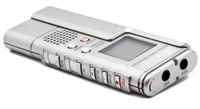Digital Audio Recorders
Digital audio recorders were a real break with the century-old traditions of recording in the music industry. Prior to digital audio recorders, there was only one kind of sound recording. After the appearance of digital recording, the world was divided into “analog” and “digital” sounds.
The story of digital recording actually has its roots in the history of computing and telephones rather than sound recording. From the 1930s, onward, telephone companies experimented with ways to break up telephone signals into small pieces rather than continuous flows of electricity. They were looking for ways to “compress” sound and make it easier to send multiple signals over a single wire. This effort was at first unrelated to the development of computers, but by the late 1940s, computer engineers had developed ways to record digital data on magnetic tape.
In the 1950s and 1960s, the technologies for converting sound into digital bits and recording it on tape gradually improved to the point where it became possible to record high-quality sound digitally. But record companies were not particularly interested. It was not yet possible to build an inexpensive consumer device to play a digital recording, and digital tape recorders did not offer any particular advantages over the multi-track analog recorders then being introduced.
Much of the stimulus for the shift from analog to digital recording in studios came not from the music industry, but from television. There, digital video recorders caught on quickly after they were introduced in the 1970s. With these established, engineers found ways to convert digital video recorders to digital audio recorders, and one of the first commercially available digital audio recorders was based on a converted VCR. An important milestone was the emergence of the Soundstream company, where engineer Thomas Stockham designed a digital audio recorder that he used to record the Santa Fe, New Mexico Symphony Orchestra in 1976. Within a few years, digital recorders had become common in the record industry, where they were used to make the master recordings from which LP records were produced. The 1978 introduction of the Sony PCM-1600, a Betamax video recorder modified to be a digital audio recorder, was used to make the master recordings for the first CDs in 1980. The use of digital recorders gradually spread from record mastering to the recording studio, and then to the consumer by the late 1990s.
